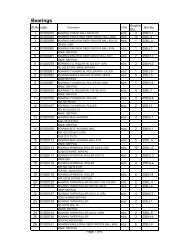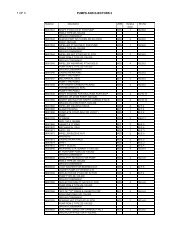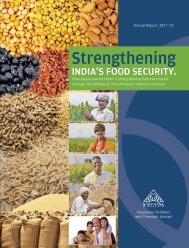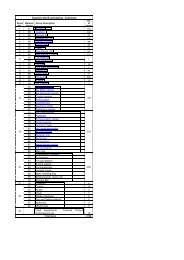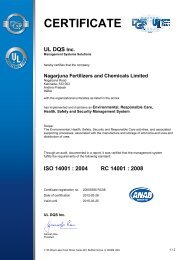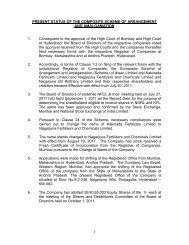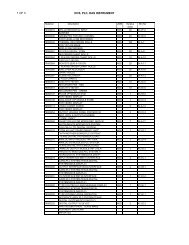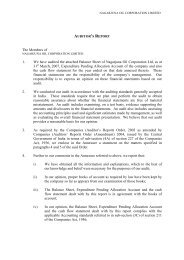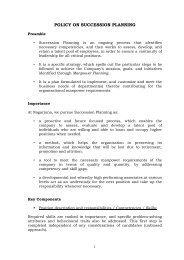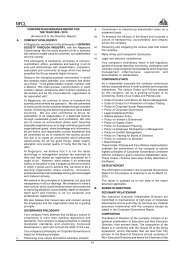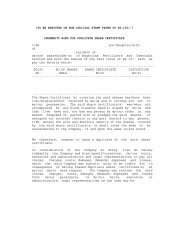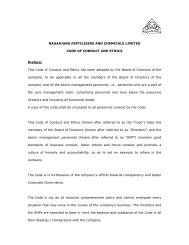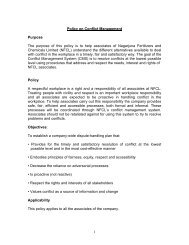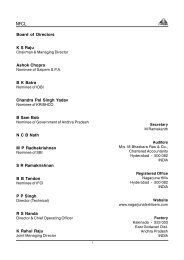Annual Report 2004 - Nagarjuna Fertilizers
Annual Report 2004 - Nagarjuna Fertilizers
Annual Report 2004 - Nagarjuna Fertilizers
Create successful ePaper yourself
Turn your PDF publications into a flip-book with our unique Google optimized e-Paper software.
NFCL<br />
MANAGEMENT DISCUSSION AND ANALYSIS<br />
1. INDUSTRY SCENARIO AND DEVELOPMENT<br />
Agriculture plays a dominant role in the Indian<br />
economy and ¼ of our GDP comes from this sector.<br />
The critical role of agriculture in the growth of Indian<br />
economy has been well established. The fortunes of<br />
the fertilizer industry are linked to the agriculture sector<br />
and good quality fertilizers plays an important role in<br />
increasing production and productivity.<br />
The need of the day is to call for a second green<br />
revolution to bring about further jump in the quantum<br />
of production of agricultural products in the country to<br />
meet the ever growing demand of the masses.<br />
Your company has significantly contributed in this area<br />
and is gearing up to meet the demands of the second<br />
green revolution. Your company’s Urea Plants located<br />
at Kakinada meet more than half the demand of Urea<br />
for the state of Andhra Pradesh, a major share for<br />
West Bengal and Orissa and part demand for<br />
Chattisgarh.<br />
The year saw an increase in the demand of fertilizers<br />
as compared to the previous years and this demand<br />
was met by the increased production by various<br />
fertilizer companies in the country. This was in view of<br />
additional capacity not having been set up during the<br />
previous years as investment in the fertilizer industry<br />
was not yielding attractive returns. Your company<br />
also met the increased demand by increasing its<br />
production while at the same time marketing imported<br />
urea to maintain its market presence in the various<br />
states.<br />
During the year 2003-<strong>2004</strong>, against a demand of<br />
214.08 Lakh Tonne of urea availability stood at 223.68<br />
Lakh Tonne. The cumulative production of Urea during<br />
<strong>2004</strong>-05 was 202.63 Lakh Tonne against the target<br />
of 193.69 Lakh Tonne. The sale of urea during Rabi<br />
<strong>2004</strong>-05 was 107.67 Lakh Tonne, higher by about<br />
5% compared to the sale of 102.59 Lakh Tonne in<br />
the corresponding period of the previous year and<br />
was the highest sale during any Rabi season. The<br />
cumulative import of urea up to March 2005 has been<br />
6.41 Lakh Tonne on all India basis.<br />
The annual installed capacity of 205.12 Lakh MT of<br />
urea in India coupled with imports from Oman Indian<br />
<strong>Fertilizers</strong> project having production capacity of 16.52<br />
Lakh MT per annum of urea will be sufficient to meet<br />
the demand in the country, in the near future. The<br />
Department of <strong>Fertilizers</strong> had decided to continue<br />
with 50% distribution decontrol of total urea production<br />
during the FY <strong>2004</strong>-05 as the department did not<br />
see any likely hood of shortages in any pocket of the<br />
country.<br />
The identification of several new gas finds is set to<br />
improve domestic availability of feedstock and with<br />
infrastructure for import of LNG getting ready,<br />
feedstock availability would improve in the near future.<br />
The Industry nevertheless continued to face the twin<br />
problems arising out of the Policies of the Government<br />
in relation to under recovery of costs and sharing of<br />
profit as well as non availability of adequate quantity<br />
of natural gas to produce low cost Urea. The gas<br />
based units are being forced to use costlier feed<br />
stock in the form of Naphtha to maintain their<br />
production levels.<br />
The recently announced policies concerning new and<br />
expansion projects and investment in debottlenecking<br />
and switch over to LNG suffer from various anomalies.<br />
These anomalies need to be overcome to give a fillip<br />
to the existing industries to increase production while<br />
at the same time invite fresh investment into the<br />
sector. The subsidy outflow of the Government<br />
continues to rise and its effort to find ways and means<br />
to reduce the subsidy without correcting the farmgate<br />
price is resulting in severe strain on the profitability<br />
and cash flow of the existing companies.<br />
A Committee formed under Dr. Y. K. Alagh is<br />
contemplating a new urea pricing policy for stage –III,<br />
scheduled to commence from April 2006. The subcommittee<br />
is deliberating upon making urea available<br />
to farmers at reasonably affordable prices and reduce<br />
expenditure on subsidy to urea manufacturers. The<br />
report by Alagh committee will make the policy<br />
directions clear on the issues of - availability of<br />
feedstock, feedstock costs, farm gate prices, and<br />
subsidy to domestic players. The fertilizer industry<br />
has been representing to be deshackled from the<br />
subsidy regime and be made to compete on global<br />
terms.<br />
2. ORGANIZATION CHANGE INITIATIVES –<br />
ACHIEVING BUSINESS EXCELLENCE THROUGH<br />
PEOPLE, STRUCTURE, PROCESSES AND<br />
TECHNOLOGY<br />
The company proposes implementation of People<br />
and Organization Structure related policies in the<br />
current year. The logical extension of revamping of<br />
People and Structure related policies and practices<br />
are to assess the functional capabilities, identify gaps<br />
and develop a roadmap to fill those gaps.<br />
The company also proposes to institutionalise and<br />
re-engineer the business processes, right from<br />
Strategic Planning to Customer Relationship<br />
Management (CRM) in order to have a lean,<br />
responsive system and meet Quality, Speed, Reliability,<br />
Cost Effectiveness and Flexibility criteria. Collectively,<br />
the People, Structure, Processes and Technology<br />
related initiatives would build an agile, efficient,<br />
responsive organization with adequate transparency,<br />
empowerment and accountability. This is an effort to<br />
build overall Organizational capabilities to proactively<br />
handle the emerging business challenges – both at<br />
macro and micro level.<br />
3. COMPANY’S STRENGTHS<br />
Your company’s Plants are amongst the most energy<br />
efficient plants in the world. Your company also<br />
achieved one of the lowest energy levels during the<br />
current financial year. Your company is taking<br />
adequate steps in achieving high levels of production<br />
during the year in view of the increased demand for<br />
Urea as also gear up its marketing and distribution to<br />
distribute additional Urea. Your company has taken<br />
18



